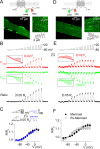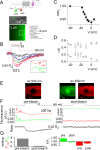Tracking the sarcoplasmic reticulum membrane voltage in muscle with a FRET biosensor
- PMID: 29899059
- PMCID: PMC6080890
- DOI: 10.1085/jgp.201812035
Tracking the sarcoplasmic reticulum membrane voltage in muscle with a FRET biosensor
Abstract
Ion channel activity in the plasma membrane of living cells generates voltage changes that are critical for numerous biological functions. The membrane of the endoplasmic/sarcoplasmic reticulum (ER/SR) is also endowed with ion channels, but whether changes in its voltage occur during cellular activity has remained ambiguous. This issue is critical for cell functions that depend on a Ca2+ flux across the reticulum membrane. This is the case for contraction of striated muscle, which is triggered by opening of ryanodine receptor Ca2+ release channels in the SR membrane in response to depolarization of the transverse invaginations of the plasma membrane (the t-tubules). Here, we use targeted expression of voltage-sensitive fluorescence resonance energy transfer (FRET) probes of the Mermaid family in differentiated muscle fibers to determine whether changes in SR membrane voltage occur during depolarization-contraction coupling. In the absence of an SR targeting sequence, FRET signals from probes present in the t-tubule membrane allow calibration of the voltage sensitivity and amplitude of the response to voltage-clamp pulses. Successful SR targeting of the probes was achieved using an N-terminal domain of triadin, which completely eliminates voltage-clamp-activated FRET signals from the t-tubule membrane of transfected fibers. In fibers expressing SR-targeted Mermaid probes, activation of SR Ca2+ release in the presence of intracellular ethyleneglycol-bis(β-amino-ethyl ether)-N,N,N',N'-tetra acetic acid (EGTA) results in an accompanying FRET signal. We find that this signal results from pH sensitivity of the probe, which detects cytosolic acidification because of the release of protons upon Ca2+ binding to EGTA. When EGTA is substituted with either 1,2-bis(o-aminophenoxy)ethane-N,N,N',N'-tetraacetic acid or the contraction blocker N-benzyl-p-toluene sulfonamide, we find no indication of a substantial change in the FRET response caused by a voltage change. These results suggest that the ryanodine receptor-mediated SR Ca2+ efflux is well balanced by concomitant counterion currents across the SR membrane.
© 2018 Sanchez et al.
Figures







Comment in
-
No voltage change at skeletal muscle SR membrane during Ca2+ release-just Mermaids on acid.J Gen Physiol. 2018 Aug 6;150(8):1055-1058. doi: 10.1085/jgp.201812084. Epub 2018 Jul 3. J Gen Physiol. 2018. PMID: 29970411 Free PMC article.
Similar articles
-
Preserved Ca2+ handling and excitation-contraction coupling in muscle fibres from diet-induced obese mice.Diabetologia. 2020 Nov;63(11):2471-2481. doi: 10.1007/s00125-020-05256-8. Epub 2020 Aug 25. Diabetologia. 2020. PMID: 32840676
-
Organization of junctional sarcoplasmic reticulum proteins in skeletal muscle fibers.J Muscle Res Cell Motil. 2015 Dec;36(6):501-15. doi: 10.1007/s10974-015-9421-5. Epub 2015 Sep 15. J Muscle Res Cell Motil. 2015. PMID: 26374336 Review.
-
Dihydropyridine receptors actively control gating of ryanodine receptors in resting mouse skeletal muscle fibres.J Physiol. 2012 Dec 1;590(23):6027-36. doi: 10.1113/jphysiol.2012.237321. Epub 2012 Sep 24. J Physiol. 2012. PMID: 23006480 Free PMC article.
-
Functional effects of central core disease mutations in the cytoplasmic region of the skeletal muscle ryanodine receptor.J Gen Physiol. 2001 Sep;118(3):277-90. doi: 10.1085/jgp.118.3.277. J Gen Physiol. 2001. PMID: 11524458 Free PMC article.
-
A study of the mechanisms of excitation-contraction coupling in frog skeletal muscle based on measurements of [Ca2+] transients inside the sarcoplasmic reticulum.J Muscle Res Cell Motil. 2018 Apr;39(1-2):41-60. doi: 10.1007/s10974-018-9497-9. Epub 2018 Aug 24. J Muscle Res Cell Motil. 2018. PMID: 30143958 Review.
Cited by
-
No voltage change at skeletal muscle SR membrane during Ca2+ release-just Mermaids on acid.J Gen Physiol. 2018 Aug 6;150(8):1055-1058. doi: 10.1085/jgp.201812084. Epub 2018 Jul 3. J Gen Physiol. 2018. PMID: 29970411 Free PMC article.
-
Is the Debate on the Flecainide Action on the RYR2 in CPVT Closed?Circ Res. 2021 Feb 5;128(3):332-334. doi: 10.1161/CIRCRESAHA.121.318706. Epub 2021 Feb 4. Circ Res. 2021. PMID: 33539226 Free PMC article. No abstract available.
-
Bioorthogonal, Fluorogenic Targeting of Voltage-Sensitive Fluorophores for Visualizing Membrane Potential Dynamics in Cellular Organelles.J Am Chem Soc. 2022 Jul 13;144(27):12138-12146. doi: 10.1021/jacs.2c02664. Epub 2022 Jul 1. J Am Chem Soc. 2022. PMID: 35776693 Free PMC article.
-
Fluorescent indicators for imaging membrane potential of organelles.Curr Opin Chem Biol. 2022 Dec;71:102203. doi: 10.1016/j.cbpa.2022.102203. Epub 2022 Sep 6. Curr Opin Chem Biol. 2022. PMID: 36084425 Free PMC article. Review.
-
The organic cation transporter 2 regulates dopamine D1 receptor signaling at the Golgi apparatus.Elife. 2022 Apr 25;11:e75468. doi: 10.7554/eLife.75468. Elife. 2022. PMID: 35467530 Free PMC article.
References
Publication types
MeSH terms
Substances
LinkOut - more resources
Full Text Sources
Other Literature Sources
Molecular Biology Databases
Research Materials
Miscellaneous

